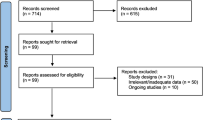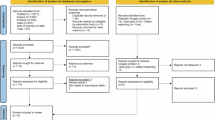Abstract
Data sources PubMed/Medline, Scopus and Cochrane databases supplemented by hand searches in the journals; Clinical Oral Implants Research, Journal of Oral Rehabilitation, The Journal of Prosthetic Dentistry, Journal of Prosthodontics and Journal of Dentistry.
Study Selection Randomised controlled clinical trials (RCTs), prospective studies with ≥ ten participants and follow-up periods ≥ six months, published in English, and comparing splinted and unsplinted attachment systems within the same study.
Data extraction and synthesisTwo investigators independently performed the electronic search; of which one collected the data while the other investigator verified it. A third investigator was involved in cases of disagreement. The Kappa test was also used to determine the inter-examiner agreement. The risk of bias was analysed using the Cochrane Risk of Bias Tool and the Newcastle-Ottawa scale.
Results Nine studies were included; six RCTs, two prospective studies and one crossover study, involving the placement of 984 implants in 380 patients and a mean follow-up period of five years. All implants were placed in the mandibular arch. The included studies demonstrated a low or unclear risk of bias. Both splinted and unsplinted attachment systems performed similarly, with no statistically significant differences present in marginal bone loss, complications and implant survival.
Conclusions The choice of attachment system does not seem to influence marginal bone loss, the incidence of complications or implant survival in mandibular overdentures.
Similar content being viewed by others
Log in or create a free account to read this content
Gain free access to this article, as well as selected content from this journal and more on nature.com
or
References
Leão RS, Moraes SL, Vasconcelos BC, Lemos CA, Pellizzer E.P. Splinted and unsplinted overdenture attachment systems: A systematic review and meta-analysis. J Oral Rehabil 2018; 45: 647-656.
Tyrovolas S, Koyanagi A, Panagiotakos DB, et al. Population prevalence of edentulism and its association with depression and self-rated health. Sci Rep 2016; 6: 37083.
Payne AG, Alsabeeha NH, Atieh MA, Esposito M, Ma S, Anas El-Wegoud MA. Interventions for replacing missing teeth: attachment systems for implant overdentures in edentulous jaws. Cochrane Database Syst Rev 2018; 10: CD008001.
Gherlone EF, Sannino G, Rapanelli A, Crespi R, Gastaldi G, Capparé P. Prefabricated bar system for immediate loading in edentulous patients: A 5-year follow-up prospective longitudinal study. BioMed Res Int 2018; 2018: 7352125.
Seo Y H, Bae EB, Kim JW, et al. Clinical evaluation of mandibular implant overdentures via Locator implant attachment and Locator bar attachment. J Adv Prosthodont 2016; 8: 313-320.
Balaguer J, Ata-Ali J, Peñarrocha-Oltra D, García B, Peñarrocha-Diago M. Long-term survival rates of implants supporting overdentures. J Oral Implantol 2015; 41: 173-177.
Bryant SR, Walton JN, MacEntee MI. A 5-year randomized trial to compare 1 or 2 implants for implant overdentures. J Dent Res 2015; 94: 36-43.
Geckili O, Cilingir A, Erdogan O, et al. The influence of interimplant distance in mandibular overdentures supported by two implants on patient satisfaction and quality of life. Int J Prosthodont 2015; 28: 19-21.
Karbach J, Hartmann S, Jahn-Eimermacher A, Wagner W. Oral health-related quality of life in edentulous patients with two-vs four-locator-retained mandibular overdentures: A prospective, randomized, crossover study. Int J Oral Maxillofac Implants 2015; 30: 1143-1148.
Lemos CAA, Verri FR, Bonfante EA, Santiago Júnior JF, Pellizzer EP. Comparison of external and internal implant-abutment connections for implant-supported prostheses. A systematic review and meta-analysis. J Dent. 2018; 70: 14-22.
Ding Q, Zhang L, Geraets W, et al. Association between peri-implant bone morphology and marginal bone loss: a retrospective study on implant-supported mandibular overdentures. Int J Oral Maxillofac Implants 2017; 32: 147-155.
Schincaglia GP, Rubin S, Thacker S, Dhingra A, Trombelli L, Ioannidou E. Marginal bone response around immediate- and delayed-loading implants supporting a locator-retained mandibular overdenture: A randomized controlled study. Int J Oral Maxillofac Implants 2016; 31: 448-458.
Author information
Authors and Affiliations
Corresponding author
Rights and permissions
About this article
Cite this article
Ahmed, K. Splinted versus unsplinted overdenture attachment systems - no difference in clinical outcomes. Evid Based Dent 20, 28–29 (2019). https://doi.org/10.1038/s41432-019-0006-9
Published:
Issue date:
DOI: https://doi.org/10.1038/s41432-019-0006-9
This article is cited by
-
How to restore lower complete edentulism with implant-supported overdentures: an evidence-based clinical management
British Dental Journal (2024)



